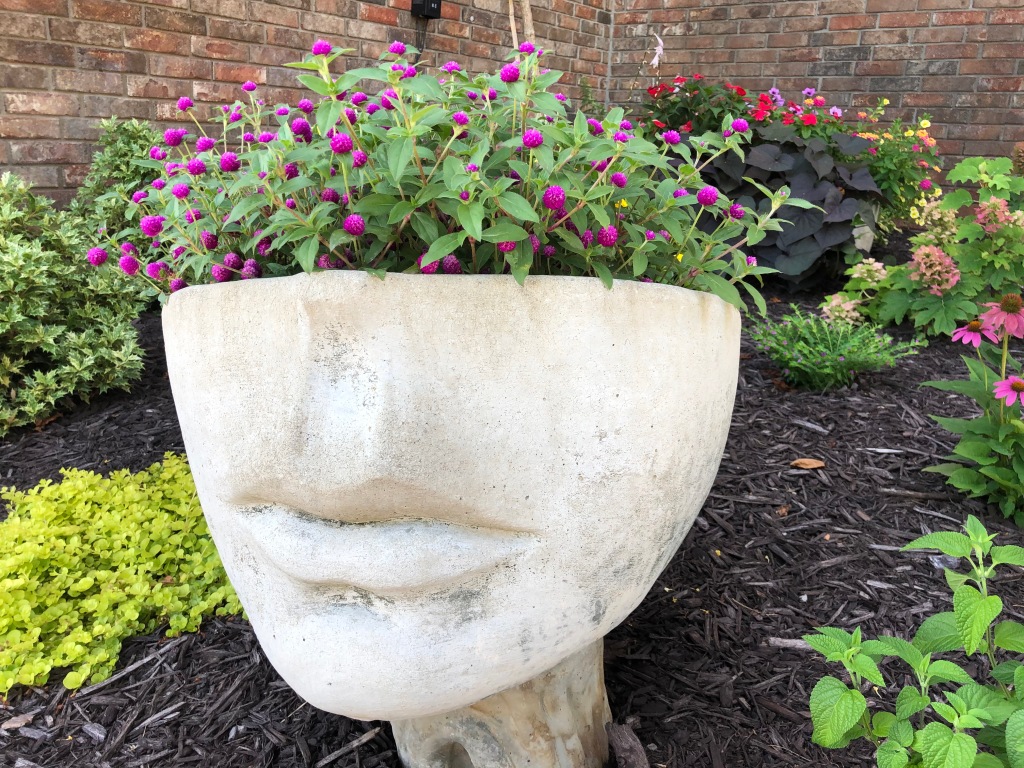Visitors to this blog are no doubt aware that one of my passions is landscape gardening. My love for flowering plants, shrubs, ornamentals, and trees has grown for over thirty years as I’ve experimented with many different species and multiple gardening designs. This avocation has given my wife and me countless hours of pleasure, along with way too many sore muscles and aching joints. In previous posts, I have highlighted some of the side benefits of gardening, such as attracting wildlife. I have also discussed pond construction projects at three different homes.
One of my posts featured the technique of stacked container plantings, which combine vertical interest with the opportunity to group many different plants together compactly. Over the years, I have really come to appreciate container gardening, which has several distinct advantages. Containers are a great option where there is no soil for planting, such as decks, patios, porches, baloneys, steps, paved walkways, or pool decking. They also work well integrated with flower or shrub beds, adding vertical and visual interest with a variety of shapes, sizes, textures, and materials. What can be used as a growing container is only limited by the gardener’s imagination.
In our gardens, we have had a plethora of containers of all shapes and sizes: red clay, glazed ceramic, plastic, coconut husk, peat, wood, metal, glass, and more. Some of these came in bright, cheerful colors. Our most substantial containers, not to mention the heaviest, are made of concrete. Their edges are at least an inch thick, and they can withstand temperatures that dip down in the single digits if they are mostly emptied in the winter and don’t hold much moisture. This feature is especially advantageous as they are much too heavy for us to move once they are in place.
Our absolute favorite concrete planter is one made of the gray cement that is typical of most driveways and foundation walls. Sounds about as basic and boring as you can get, right? What makes this offset cup-shaped planter special is how the side is sculpted in the shape of the lower half of a human face, complete with a chin, lips, philtrum, and just a hint of the lower nose. It usually sits atop a short pedestal made of the same concrete that is sculpted into the shape of a stump, but it looks more like a neck for the face planter.

The first time we saw the planter in 2009 in a garden center in north Georgia, we were smitten. We backed our pickup truck to a retaining wall with the tailgate down, and the woman running the place helped us gently roll the planter from the berm into the bed of the truck. Once we got it home, we carefully rolled it off the tailgate down a 2×12-inch board, strapped the planter to a set of hand trucks, and wheeled it around the house to its place in our patio garden.

We both observed that the face looked female and had a rather pensive expression, even without eyes. During the next rain shower, as water streamed down her cheeks, we watched the mood turn to melancholy. In all conditions, her face presents a haunting countenance, perhaps because it is lifeless. It is literally and figuratively like stone, which helped us decide on a name for the planter. “Annabel Lee” is the name of Edgar Allan Poe’s final poem, which is about the death of a beautiful woman. Now, we have our very own Annabel Lee, not “in her sepulchre there by the sea,” but in our garden for all to see.

Over the years, we have changed up the plants that finish off the top part of Annabel Lee’s face and provide her with hair. Sometimes she has locks draping down the side of her face or the back of her head. Some seasons she has a more punk, spiked look. Once or twice she has channeled Medusa, that Gorgon of Greek mythology that turns everyone else to stone! She makes a wonderful lawn decoration for Halloween and is a year-round centerpiece to the hardscape of the garden. But, at night when her very own spotlight illuminates her cheek and casts shadows across her face, Annabel Lee almost comes to life. It’s a vision powerful enough to inspire Edgar Allan Poe to write just one more verse.






